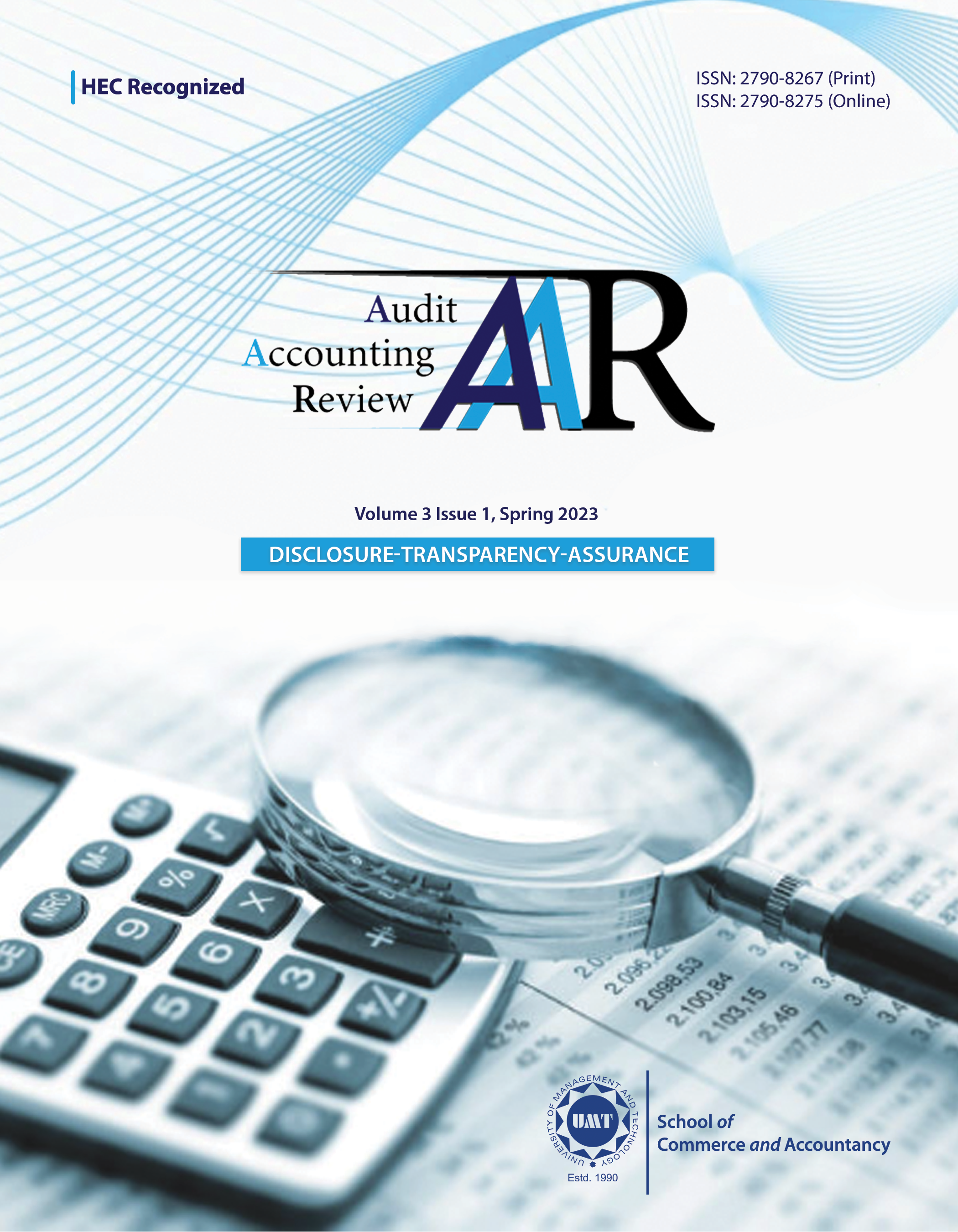Examining the relationship between Managerial Ability and Credit Ratings: A Case Study of USA Oil and Gas Sectors
Abstract
 Abstract Views: 7
Abstract Views: 7
The current study aims to investigate the association between a firm’s managerial ability and its issued credit rating. For this purpose, Twelve (12) companies in the USA oil and gas sectors have been selected based on their different work streams. A two-stage derived model of data envelopment analysis and the Tobit model is used for the measurement of firm’s managerial ability in this paper. For data envelopment analysis, cost of goods sold, fixed assets, general and administration expenses and intangible assets are used as input variable and operating revenue is used as output variable. To retain residual as firm’s managerial ability, Tobit model is estimated by using firm size, stock returns, leverage, operating cash flows and firm age as variables. The value of correlation test between credit ratings and firm’s managerial ability is 0.163, which indicates that there is positive linear relationship. Moreover, it is identified that an associated managerial ability is increased by 100%, credit rating also increased by 16.3%. The relationship between managerial ability and credit rating is significant and positive for USA oil and gas sectors from the period of 2006-2020. While regression analysis for all oil and gas companies of the USA indicated that 2.7% changes in credit rating occurred due to managerial ability. Therefore, this study suggests to enhance the managerial ability of firms, which leads to higher credit rating and consequently less cost of debt for their debt instruments.
Downloads
References
Abuhommous, A. A. A., Alsaraireh, A. S., & Alqaralleh, H. (2022). The impact of working capital management on credit rating. Financial Innovation, 8, Article e72. https://doi.org/10.1186/s40854-022-00376-z
Aktug, R. E., Nayar, N., & Salas, J. M. (2015). Are credit rating agency analysts valuable? The Journal of Risk Finance, 16(4), 378–394. https://doi.org/10.1108/JRF-11-2014-0159
Alali, F., Anandarajan, A., & Jiang, W. (2012). The effect of corporate governance on firm’s credit ratings: Further evidence using governance score in the United States. Accounting & Finance, 52(2), 291–312. https://doi.org/10.1111/j.1467-629X.2010.00396.x
Alissa, W., Bonsall IV, S. B., Koharki, K., & Penn Jr, M. W. (2013). Firms' use of accounting discretion to influence their credit ratings. Journal of Accounting and Economics, 55(2-3), 129–147. https://doi.org/10.1016/j.jacceco.2013.01.001
Andreou, P. C., Ehrlich, D., & Louca, C. (2013, January). Managerial ability and firm performance: Evidence from the global financial crisis (Paper presentation). European Financial Management Association, Annual Conference, United Kingdom.
Baber, G. (2014). The role and responsibility of credit rating agencies in promoting soundness and integrity. Journal of Money Laundering Control, 17(1), 34–49. https://doi.org/10.1108/JMLC-09-2013-0031
Beenen, G., Pichler, S., Livingston, B., & Riggio, R. (2021). The good manager: Development and validation of the Managerial Interpersonal Skills Scale. Frontiers in Psychology, 12, Article e631390. https://doi.org/10.3389/fpsyg.2021.631390
Benmelech, E., & Frydman, C. (2015). Military CEOs. Journal of Financial Economics, 117(1), 43–59. https://doi.org/10.1016/j.jfineco.2014.04.009
Bonsall-IV, S. B., Holzman, E. R., & Miller, B. P. (2017). Managerial ability and credit risk assessment. Management Science, 63(5), 1425–1449. https://doi.org/10.1287/mnsc.2015.2403
Boylan, S. J. (2012). Will credit rating agency reforms be effective? Journal of Financial Regulation and Compliance, 20(4), 356–366. https://doi.org/10.1108/13581981211279327
Bruno, V., Cornaggia, J., & Cornaggia, K. J. (2016). Does regulatory certification affect the information content of credit ratings? Management Science, 62(6), 1578–1597. https://doi.org/10.1287/mnsc.2015.2188
Chen, S. S., & Lin, C. Y. (2018). Managerial ability and acquirer returns. The Quarterly Review of Economics and Finance, 68, 171–182. https://doi.org/10.1016/j.qref.2017.09.004
Cornaggia, K. J., Krishnan, G. V., & Wang, C. (2017). Managerial ability and credit ratings. Contemporary Accounting Research, 34(4), 2094–2122. https://doi.org/10.1111/1911-3846.12334
Cubas-Díaz, M., & Martínez Sedano, M. Á. (2018). Do credit ratings take into account the sustainability performance of companies? Sustainability, 10(11), Article e4272. https://doi.org/10.3390/su10114272
De Franco, G., Hope, O. K., & Lu, H. (2017). Managerial ability and bank‐loan pricing. Journal of Business Finance & Accounting, 44(9-10), 1315–1337. https://doi.org/10.1111/jbfa.12267
Demerjian, P. R., Lev, B., Lewis, M. F., & McVay, S. E. (2013). Managerial ability and earnings quality. The Accounting Review, 88(2), 463–498. https://doi.org/10.2308/accr-50318
Demerjian, P., Lev, B., & McVay, S. (2012). Quantifying managerial ability: A new measure and validity tests. Management Science, 58(7), 1229–1248. https://doi.org/10.1287/mnsc.1110.1487
Fracassi, C., Petry, S., & Tate, G. (2016). Does rating analyst subjectivity affect corporate debt pricing? Journal of Financial Economics, 120(3), 514–538. https://doi.org/10.1016/j.jfineco.2016.02.006
Holden, S., Natvik, G. J., & Vigier, A. (2018). Credit rating and debt crises. International Economic Review, 59(2), 973–987. https://doi.org/10.1111/iere.12293
Huang, Q., & Xiong, M. (2022). Does managerial ability increase or decrease firm value? Applied Economics Letters, 30(13), 1717–1722. https://doi.org/10.1080/13504851.2022.2081658
Kaplan, S. N., Klebanov, M. M., & Sorensen, M. (2012). Which CEO characteristics and abilities matter? The Journal of Finance, 67(3), 973–1007. https://doi.org/10.1111/j.1540-6261.2012.01739.x
Kim, T., & Kim, I. (2020). The influence of credit scores on dividend policy: Evidence from the Korean market. The Journal of Asian Finance, Economics and Business, 7(2), 33–42. https://db.koreascholar.com/Article/Detail/387134
Koester, A., Shevlin, T., & Wangerin, D. (2017). The role of managerial ability in corporate tax avoidance. Management Science, 63(10), 3285–3310. https://doi.org/10.1287/mnsc.2016.2510
Li, Y., & Luo, Y. (2017). The contextual nature of the association between managerial ability and audit fees. Review of Accounting and Finance, 16(1), 2–20. https://doi.org/10.1108/RAF-01-2016-0012
Luo, Y., & Zhou, L. (2017). Managerial ability, tone of earnings announcements, and market reaction. Asian Review of Accounting, 25(4), 454–471. https://doi.org/10.1108/ARA-07-2016-0078
Oikonomou, I., Brooks, C., & Pavelin, S. (2014). The effects of corporate social performance on the cost of corporate debt and credit ratings. Financial Review, 49(1), 49–75. https://doi.org/10.1111/fire.12025
Saadaoui, A., Elammari, A., & Kriaa, M. (2022). Credit rating announcement and bond liquidity: The case of emerging bond markets. Journal of Economics, Finance and Administrative Science, 27(53), 86–104. https://doi.org/10.1108/JEFAS-08-2020-0314
Ting, I. W. K., Tebourbi, I., Lu, W. M., & Kweh, Q. L. (2021). The effects of managerial ability on firm performance and the mediating role of capital structure: evidence from Taiwan. Financial Innovation, 7(1), Article e89. https://doi.org/10.1186/s40854-021-00320-7
Ubarhande, P., & Chandani, A. (2021). Elements of credit rating: A hybrid review and future research Agenda. Cogent Business & Management, 8(1), Article e1878977. https://doi.org/10.1080/23311975.2021.1878977
Venkiteshwaran, V. (2014). Do asset sales affect firm credit risk? Evidence from credit rating assignments. Managerial Finance, 40(9), 903–927. https://doi.org/10.1108/MF-09-2012-0196
Xia, H. (2014). Can investor-paid credit rating agencies improve the information quality of issuer-paid rating agencies? Journal of Financial Economics, 111(2), 450–468. https://doi.org/10.1016/j.jfineco.2013.10.015
Zhao, Q. (2017). Do managers manipulate earnings to influence credit rating agencies’ decisions? Evidence from watchlist. Review of Accounting and Finance, 16(3), 366–384. https://doi.org/10.1108/RAF-05-2016-0078
Huang, Q., Xiong, M., & Xiao, M. (2022). Does managerial ability affect corporate financial constraints? Evidence from China. Economic Research-Ekonomska Istraživanja, 35(1), 3731–3753. https://doi.org/10.1080/1331677X.2021.2004186
Andreou, P. C., Karasamani, I., Louca, C., & Ehrlich, D. (2017). The impact of managerial ability on crisis-period corporate investment. Journal of Business Research, 79, 107–122. https://doi.org/10.1016/j.jbusres.2017.05.022
Masood, O., Bashir, F., & Sahi, A. I. (2017). Sovereign credit rating changes and its impact on financial markets of Europe during debt crisis period in Greece and Ireland. Journal of Business & Financial Affairs, 6(4), Article e1000304. https://doi.org/10.4172/2167-0234.1000304
Kisgen, D. J. (2006). Credit ratings and capital structure. The Journal of Finance, 61(3), 1035–1072. https://doi.org/10.1111/j.1540-6261.2006.00866.x
Charnes, A., Cooper, W. W., & Rhodes, E. (1978). Measuring the efficiency of decision making units. European Journal of Operational Research, 2(6), 429–444. https://doi.org/10.1016/0377-2217(78)90138-8
Tobin, J. (1958). Estimation of relationships for limited dependent variables. Econometrica: Journal of the Econometric Society, 26(1), 24–36. https://doi.org/10.2307/1907382
Copyright (c) 2023 Chaudhry Abdullah Imran Sahi

This work is licensed under a Creative Commons Attribution 4.0 International License.
Authors retain copyright and grant the journal right of first publication with the work simultaneously licensed under a Creative Commons Attribution (CC-BY) 4.0 License that allows others to share the work with an acknowledgement of the work’s authorship and initial publication in this journal.







